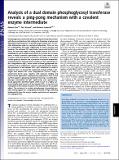| dc.contributor.author | Das, Debasis | |
| dc.contributor.author | Kuzmic, Petr | |
| dc.contributor.author | Imperiali, Barbara | |
| dc.date.accessioned | 2018-04-05T15:35:48Z | |
| dc.date.available | 2018-04-05T15:35:48Z | |
| dc.date.issued | 2017-06 | |
| dc.date.submitted | 2017-02 | |
| dc.identifier.issn | 0027-8424 | |
| dc.identifier.issn | 1091-6490 | |
| dc.identifier.uri | http://hdl.handle.net/1721.1/114569 | |
| dc.description.abstract | Phosphoglycosyl transferases (PGTs) are integralmembrane proteins with diverse architectures that catalyze the formation of polyprenol diphosphate-linked glycans via phosphosugar transfer from a nucleotide diphosphate-sugar to a polyprenol phosphate. There are two PGT superfamilies that differ significantly in overall structure and topology. The polytopic PGT superfamily, represented by MraY and WecA, has been the subject of many studies because of its roles in peptidoglycan and O-antigen biosynthesis. In contrast, less is known about a second, extensive superfamily of PGTs that reveals a core structure with dual domain architecture featuring a C-terminal soluble globular domain and a predicted N-terminal membraneassociated domain. Representative members of this superfamily are the Campylobacter PglCs, which initiate N-linked glycoprotein biosynthesis and are implicated in virulence and pathogenicity. Despite the prevalence of dual domain PGTs, their mechanism of action is unknown. Here, we present the mechanistic analysis of PglC, a prototypic dual domain PGT from Campylobacter concisus. Using a luminescence-based assay, together with substrate labeling and kinetics-based approaches, complementary experiments were carried out that support a ping-pong mechanism involving a covalent phosphosugar intermediate for PglC. Significantly, mass spectrometrybased approaches identified Asp93, which is part of a highly conserved AspGlu dyad found in all dual domain PGTs, as the active-site nucleophile of the enzyme involved in the formation of the covalent adduct. The existence of a covalent phosphosugar intermediate provides strong support for a ping-pong mechanism of PglC, differing fundamentally from the ternary complex mechanisms of representative polytopic PGTs. Keywords: phosphoglycosyl transferase; membrane protein; dual domain PGT; covalent intermediate; glycoconjugate biosynthesis | en_US |
| dc.description.sponsorship | National Institutes of Health (U.S.) (Grant GM-039334) | en_US |
| dc.publisher | National Academy of Sciences (U.S.) | en_US |
| dc.relation.isversionof | http://dx.doi.org/10.1073/PNAS.1703397114 | en_US |
| dc.rights | Article is made available in accordance with the publisher's policy and may be subject to US copyright law. Please refer to the publisher's site for terms of use. | en_US |
| dc.source | National Academy of Sciences | en_US |
| dc.title | Analysis of a dual domain phosphoglycosyl transferase reveals a ping-pong mechanism with a covalent enzyme intermediate | en_US |
| dc.type | Article | en_US |
| dc.identifier.citation | Das, Debasis et al. “Analysis of a Dual Domain Phosphoglycosyl Transferase Reveals a Ping-Pong Mechanism with a Covalent Enzyme Intermediate.” Proceedings of the National Academy of Sciences 114, 27 (June 2017): 7019–7024 | en_US |
| dc.contributor.department | Massachusetts Institute of Technology. Department of Biology | en_US |
| dc.contributor.department | Massachusetts Institute of Technology. Department of Chemistry | en_US |
| dc.contributor.mitauthor | Das, Debasis | |
| dc.contributor.mitauthor | Imperiali, Barbara | |
| dc.relation.journal | Proceedings of the National Academy of Sciences | en_US |
| dc.eprint.version | Final published version | en_US |
| dc.type.uri | http://purl.org/eprint/type/JournalArticle | en_US |
| eprint.status | http://purl.org/eprint/status/PeerReviewed | en_US |
| dc.date.updated | 2018-03-30T18:29:22Z | |
| dspace.orderedauthors | Das, Debasis; Kuzmic, Petr; Imperiali, Barbara | en_US |
| dspace.embargo.terms | N | en_US |
| dc.identifier.orcid | https://orcid.org/0000-0001-8967-3348 | |
| dc.identifier.orcid | https://orcid.org/0000-0002-5749-7869 | |
| mit.license | PUBLISHER_POLICY | en_US |
